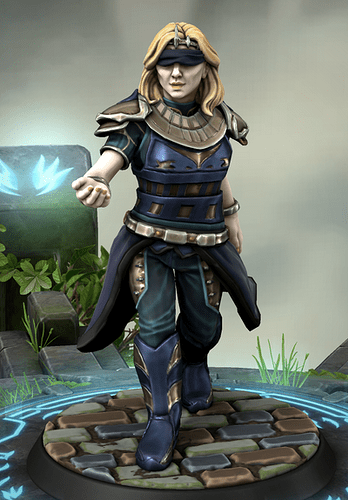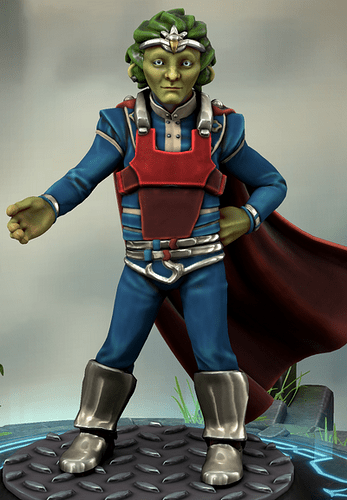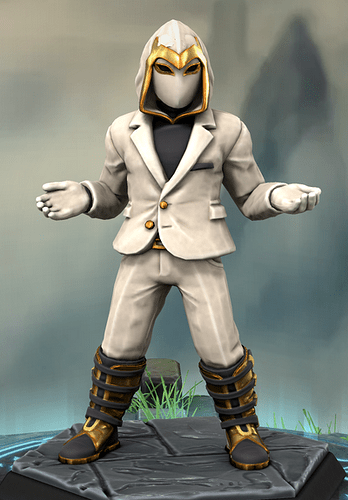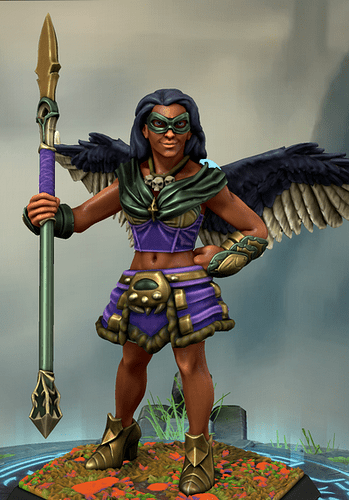Okay, this entry is a bit of an odd one, formatting-wise, because the first two paragraphs are going to be in other sources in the book but I’m just putting them at the start of the introduction. Feel like it’s important to get how we get to…
Caliban
Real Name: William Handler, First Appearance: (heroic) If We Shadows Have Offended #1, July 2015
Background: Criminal, Power Source: Genetic, Archetype: Speedster
Personality: Alluring, Principles: Reformer, Detective
Status Dice: Green d6, Yellow d8, Red d12. Health: 34 [Green 34-26, Yellow 25-13, Red 12-1]
Qualities: Acrobatics d10, Investigation d10, Finesse d8, Criminal Underworld d8, Dashing Thief d8
Powers: Presence d10, Agility d10, Speed d8, Awareness d6
Green Abilities:
- Set the Scene [A]: Attack using Acrobatics. Other nearby heroes in the Yellow or Red zone Recover equal to your Min die.
- Step Lightly [A]: Attack using Acrobatics. Defend yourself using your Min die.
- Dance Partner [A]: Boost or Hinder using Presence. Use your Max die. If you roll doubles, you may also Attack using your Mid die.
- Principle of the Reformer [A]: Overcome by offering someone a second chance and use your Max die. You and each of your allies gain a hero point.
- Principle of the Detective [A]: Overcome to learn hidden information and use your Max die. You and each of your allies gain a hero point.
Yellow Abilities:
- Change Partners [A]: Attack multiple targets using Agility, using your Min die against each.
- Swing and a Hit [A]: Attack using Acrobatics. Use your Max die. If you roll doubles, use Max+Min instead.
- Take a Bow [R]: When damaged by an environment target or a surprise Attack, Defend by rolling your single Presence die.
Red Abilities
- Already Solved It [A]: Overcome using Investigation. Use your Max+Min dice. Hinder all nearby opponents with your Mid die.
- Taunt [R]: When an opponent Attacks, you may become the target of that Attack and Defend by rolling your single Red zone die.
Out
- Boost an ally by rolling your single Presence die.
Added to the Headmaster’s writeup: The addition of the Headmaster to the criminal underworld of Ferrisville led to unexpected allies and enemies rising in response. One of these was the superhuman thief Caliban. During this period, Caliban was making sporadic appearances throughout the pages of Venture Comics as he struggled with his pain and guilt. In Company Town, he briefly clashed with Paradox, had a long conversation with her about grief and loss, and intermittently joined forces with the Rogue Agents to undermine the Headmaster and Mr. Ferris for a few years, before vanishing again in early 2007.
Added to Greensleeves: One of Greensleeves’ major stories in 2009 involved the re-appearance of Caliban. In Kid Liberty and the Champions of Tomorrow #14, Caliban came out of nowhere, determined to kill Greensleeves in order to force the powers within her to return to Greenheart. He scornfully told the Champions of Tomorrow that they were failures, and would never be as important or powerful as the Champions of Truth; to restore one of the world’s greatest heroes, he was willing to have their blood on his hands. In the end, he was defeated and fled, but his words would prove to be darkly prophetic.
And then the actual entry:
Following his appearance in Kid Liberty and the Champions of Tomorrow, Caliban went through a spate of increasingly grim appearances. During the Night of Lost Souls, he appeared to protect Greenheart from a zombified Prospero, killing his father for a second time and telling Greenheart that there was no one he would not kill for her. Throughout 2011-2013, he seemed to be living up to that reputation, killing business leaders and wealthy heirs with no regard to their actual crimes, and mocking both Greenheart and Paradox when they tried to confront him. In 2013, after trying to rein him in, Greenheart finally didn’t hold back, fighting Caliban and almost killing him before he escaped. It seemed to be the final nail in the coffin of their relationship.
Fans thus greeted news that Caliban would be returning in a 2015 miniseries titled If We Shadows Have Offended with trepidation. But there was some hope that the series might turn things around. So it wasn’t entirely a surprise to many readers when they opened the first page and learned that Caliban had been living on a tropical island in the South Pacific since his final appearance in Cryptic Trails in 2008, and his first inkling that something was off was when he opened a newspaper and learned that ‘Caliban’ had just committed a series of daring crimes on behalf of the Headmaster, killing several people.
Once he was back in the game, it didn’t take long for Caliban to realize what had happened. His sister, wanting to punish both him and Greenheart, had taken advantage of his absence and hired the Red Herring to impersonate him, with the goal of ruining his reputation and destroying Greenheart’s life. The master mimic had done so with gusto, and now Caliban was faced with the need to clear his name, avoid the police, and repair the damage that his family had done once again. Rather than digging up old wounds by going to Greenheart, however, Caliban reached out to the one person that he thought might be willing to help – Paradox.
Over the course of five chaotic issues, Caliban and Paradox went toe to toe with the Red Herring’s vast operation, pushing his way through layers of deception and creating havoc for his operations as he gathered the evidence he needed to prove that each of the crimes he was accused of had been committed by the other villain while reaching out to his family to bring them back from the edge. In the final issue, Caliban confronted Ariel and Scion directly, telling his sisters that he was sorry for what had happened between them, but that he no longer regretted it. It was Prospero who destroyed their family, not Greenheart. Scion refused his offer of reconciliation, but Ariel accepted, pulling back from the brink and agreeing to let Caliban and Paradox help her.
In the aftermath of the story, Caliban was back on somewhat solid ground. The retcon that he had been impersonated managed to satisfy both fans of the character and fans who had been afraid of the events of the past few years being brushed under the carpet to ‘redeem’ him; he was still a wanted criminal for the crimes he had committed, but he was determined to use his skills for good, and to make up for the harm he had caused. He made peace with Greenheart, apologizing for abandoning her instead of letting her help him, and began to appear in occasional issues of Company Town lending a hand to the Rogue Agents again.
Behind the Scenes
And there we go! I told you that all of our Plutonium Age heroes would be people that you knew.
There was a lot of discussion about a pointless “Caliban turns evil” arc that gets retconned later, and this is it. I suspect that the Red Herring has been used in the past for “wildly out of character villain” storylines, but this is one that helps to buff up his heat by reminding people that he’s dangerous, while also giving Caliban a solid villain to wrestle with. It also helps to cement a Caliban - Paradox friendship, which is going to be important in a little while.





